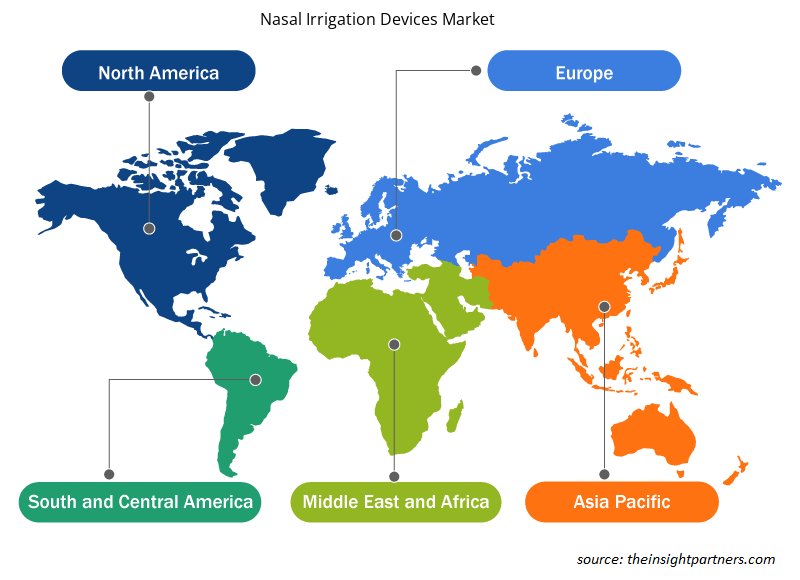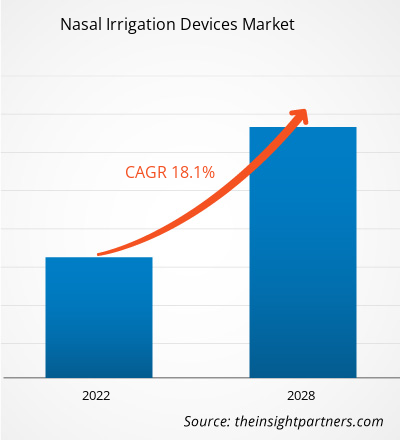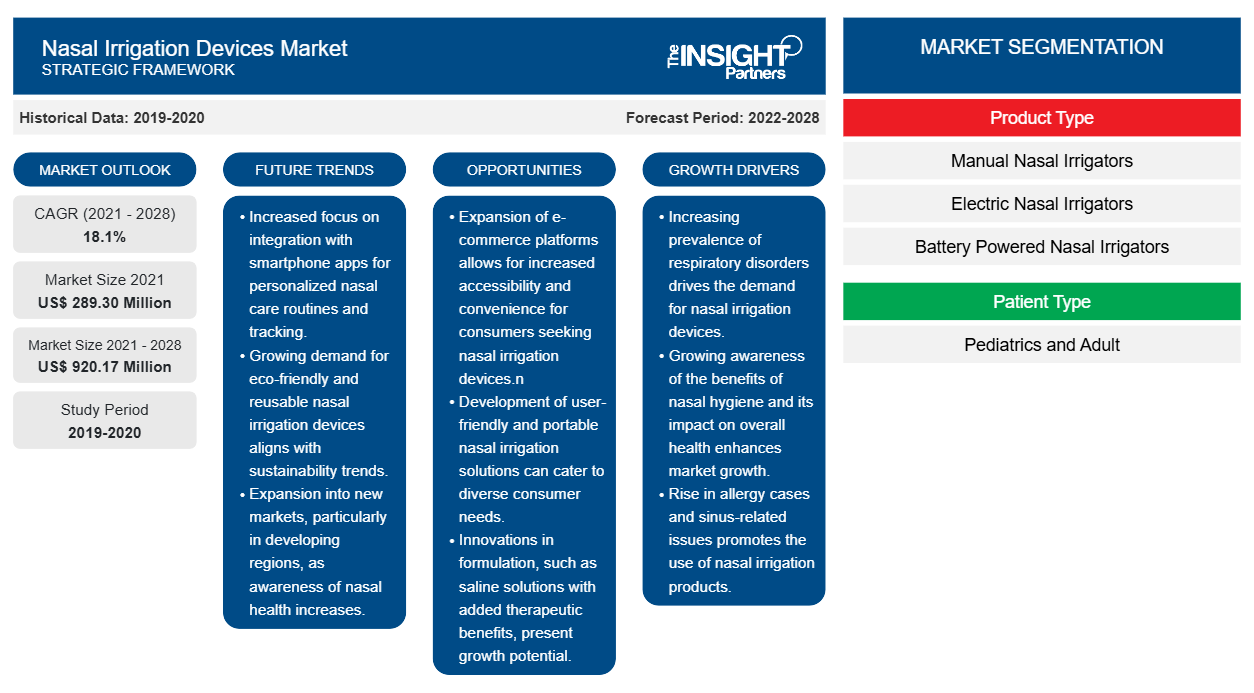Der Markt für Geräte zur Nasendusche hatte im Jahr 2021 einen Wert von 289,30 Millionen US-Dollar und dürfte von 2022 bis 2028 mit einer durchschnittlichen jährlichen Wachstumsrate von 18,1 % wachsen.
Nasenduschen sind eine traditionelle Methode zur Reinigung der Nasengänge mithilfe von Kochsalzlösung und destilliertem Wasser. Dabei kommen Geräte wie Nasenduschen, Quetschflaschen und elektrische Nasenduschen zum Einsatz. Diese Geräte verfügen über speziell entwickelte Düsen, die eine effiziente und effektive Reinigung der Nasengänge ermöglichen.
Der Markt für Nasenspülgeräte ist nach Produkttyp, Patiententyp, Anwendung, Endbenutzer und Geografie segmentiert. Geografisch ist der Markt grob in Nordamerika, Europa, Asien-Pazifik, den Nahen Osten und Afrika sowie Süd- und Mittelamerika segmentiert. Dieser Bericht bietet Einblicke und eine eingehende Analyse des Marktes und betont Parameter wie Markttrends und Marktdynamik. Er enthält auch die Wettbewerbsanalyse der führenden Akteure auf dem Markt für Nasenspülgeräte.
Passen Sie diesen Bericht Ihren Anforderungen an
Sie erhalten kostenlos individuelle Anpassungen an jedem Bericht, einschließlich Teilen dieses Berichts oder einer Analyse auf Länderebene, eines Excel-Datenpakets sowie tolle Angebote und Rabatte für Start-ups und Universitäten.
-
Holen Sie sich die wichtigsten Markttrends aus diesem Bericht.Dieses KOSTENLOSE Beispiel umfasst eine Datenanalyse von Markttrends bis hin zu Schätzungen und Prognosen.
Markteinblicke
Anstieg der Prävalenz von Nasenallergien und Infektionskrankheiten sowie zunehmendes Bewusstsein für die Vorteile der Nasendusche treiben das Marktwachstum für Nasenduschen voran
In den letzten Jahren gab es einen deutlichen Anstieg der Fälle von Allergien und Infektionskrankheiten der oberen Atemwege. Es gab einen erheblichen Anstieg von Sinusitis, Rhinitis, Bronchiolitis und anderen postoperativen Erkrankungen, die für eine schnelle Genesung eine Nasenspülung erfordern; weitere Entzündungen und Bakterienablagerungen können den Zustand verschlimmern. Laut einem Bericht des Sinus & Allergy Wellness Center leiden in den USA jährlich 30 Millionen Erwachsene an Sinusitis; im Jahr 2020 wurde bei ~11,6 % der amerikanischen Erwachsenen eine Sinusitis diagnostiziert. Daher hat die zunehmende Verbreitung von Sinusitis die Aktivitäten eines Einzelnen beeinflusst, die Nachfrage nach Nasenspülungen gefördert und den Markt für Nasenspülgeräte angetrieben. Ein Anstieg der Prävalenz von Infektionen der oberen Atemwege im Zuge der rasanten Industrialisierung und der steigenden Umweltverschmutzung treibt auch die Nachfrage nach Nasenspülgeräten an. Mit zunehmender Umweltverschmutzung können Allergene und Schadstoffe in der Luft eine Verstopfung der Nasengänge verursachen, und die übermäßige Ablagerung solcher Chemikalien oder Substanzen kann außerdem zu Nebenhöhlenentzündungen und anderen Nasenproblemen führen. Nasenspülungen helfen, Allergene auszuwaschen, Flüssigkeiten herauszuziehen, die Atmung zu verbessern, die Nebenhöhlen zu befreien usw. In letzter Zeit ist das Bewusstsein dieser Vorteile bei den Verbrauchern gestiegen, was zu einer hohen Nachfrage nach Nasenspülgeräten führt.
Die Nasendusche, die heute weltweit angewendet wird, hat eine lange Geschichte, die bis ins Ayurveda zurückreicht. Dennoch haben sich Nasenduschen deutlich weiterentwickelt, von Quetschflaschen zu Nasenduschen. Batteriebetriebene und elektrische Nasenduschen, die immer beliebter werden, ermöglichen einen gleichmäßigen Fluss von Salzwasser in die Nasenhöhle. Entwicklungsländer im asiatisch-pazifischen Raum sowie in Süd- und Mittelamerika konzentrieren sich auf die Entwicklung und Nutzung solcher Geräte. PT Kalbe Farma Tbk hat den ersten elektrischen Nasenreiniger auf den Markt gebracht, der jemals in Indonesien unter dem Markennamen Elvasense Portable Nasal Washer hergestellt wurde. Die kontinuierliche Entwicklung neuartiger Geräte für bessere Ergebnisse und eine Steigerung der Produktion von Nasenduschen in Entwicklungsländern dürften im Prognosezeitraum lukrative Möglichkeiten für das Wachstum des Marktes schaffen.
Einblicke in Produkttypen
Basierend auf dem Produkttyp ist der Markt für Nasenduschen in manuelle Nasenduschen, elektrische Nasenduschen und batteriebetriebene Nasenduschen unterteilt. Das Segment der manuellen Nasenduschen ist weiter unterteilt in Neti-Kännchen, Quetschflaschen und Baby-Ballspritzen. Das Segment der manuellen Nasenduschen hatte 2021 den größten Marktanteil. Es wird jedoch erwartet, dass das Segment der batteriebetriebenen Nasenduschen im Prognosezeitraum aufgrund des steigenden Trends zu tragbaren Gesundheitsprodukten die höchste durchschnittliche jährliche Wachstumsrate verzeichnet.
Einblicke in den Patiententyp
Basierend auf dem Patiententyp ist der Markt für Nasenspülgeräte in Erwachsene und Kinder unterteilt. Im Jahr 2021 hatte das Erwachsenensegment einen größeren Marktanteil. Darüber hinaus wird erwartet, dass dasselbe Segment von 2022 bis 2028 mit der höchsten CAGR wächst. Die Marktdominanz dieses Segments ist auf die steigende Nachfrage nach Nasenspülgeräten zur Behandlung von Nebenhöhlenentzündungen, Allergien, Erkältungen und Grippe zurückzuführen, insbesondere unter der wachsenden geriatrischen Bevölkerung weltweit.
Anwendungseinblicke
Basierend auf der Anwendung ist der Markt für Nasenduschen in Nebenhöhlenentzündungen, Rhinitis, Bronchiolitis, postoperative Atemwegserkrankungen und andere unterteilt. Im Jahr 2021 hatte das Nebenhöhlensegment den größten Marktanteil. Außerdem wird erwartet, dass dasselbe Segment von 2022 bis 2028 die höchste durchschnittliche jährliche Wachstumsrate verzeichnet. Das Marktwachstum dieses Segments ist auf die zunehmenden Nebenhöhlenentzündungen und Initiativen wichtiger Akteure zurückzuführen.
Erkenntnisse für Endbenutzer
Basierend auf dem Endverbraucher ist der Markt für Nasenduschen in häusliche Pflegeeinrichtungen, Krankenhäuser und Kliniken und andere unterteilt. Im Jahr 2021 hält das Segment der häuslichen Pflegeeinrichtungen den größten Marktanteil und wird voraussichtlich von 2022 bis 2028 die schnellste CAGR verzeichnen.
Anorganische Entwicklungen wie Fusionen und Übernahmen sowie Expansion sind bei den Akteuren auf dem globalen Markt für Nasenduschen weit verbreitete Strategien. Nachfolgend sind einige der jüngsten wichtigen Marktentwicklungen aufgeführt:
- Im Mai 2022 gab Medtronic die Übernahme von Intersect ENT bekannt und erweiterte damit das umfassende Hals-Nasen-Ohren-Portfolio des Unternehmens um innovative Produkte, die bei Nasennebenhöhlenoperationen zur Verbesserung der postoperativen Ergebnisse und zur Behandlung von Nasenpolypen eingesetzt werden. Die Produktlinien und der Kundenstamm von Intersect ENT werden Medtronics Bemühungen unterstützen, Patienten mit chronischer Rhinosinusitis (CRS) positiv zu beeinflussen.
- Im November 2021 kündigte NeilMed Phamaceuticals Inc. eine erhebliche Erweiterung seiner Produktionsanlagen in Sonoma County an, da die Umsätze insbesondere außerhalb der USA steigen.
- Im Oktober 2021 gab Air Liquide die Übernahme von Betamed SA, einem großen Anbieter von häuslicher Gesundheitspflege in Polen, bekannt, um sein Geschäft mit häuslicher Gesundheitspflege in Europa auszubauen.
Markt für Nasenduschen – regionale Einblicke
Die regionalen Trends und Faktoren, die den Markt für Nasenspülgeräte im Prognosezeitraum beeinflussen, wurden von den Analysten von Insight Partners ausführlich erläutert. In diesem Abschnitt werden auch die Marktsegmente und die Geografie von Nasenspülgeräten in Nordamerika, Europa, im asiatisch-pazifischen Raum, im Nahen Osten und Afrika sowie in Süd- und Mittelamerika erörtert.

- Erhalten Sie regionale Daten zum Markt für Nasenspülgeräte
Marktbericht zu Nasenspülgeräten – Umfang
| Berichtsattribut | Details |
|---|---|
| Marktgröße im Jahr 2021 | 289,30 Millionen US-Dollar |
| Marktgröße bis 2028 | 920,17 Millionen US-Dollar |
| Globale CAGR (2021 - 2028) | 18,1 % |
| Historische Daten | 2019-2020 |
| Prognosezeitraum | 2022–2028 |
| Abgedeckte Segmente |
Nach Produkttyp
|
| Abgedeckte Regionen und Länder |
Nordamerika
|
| Marktführer und wichtige Unternehmensprofile |
|
Marktteilnehmerdichte für Nasenduschen: Auswirkungen auf die Geschäftsdynamik verstehen
Der Markt für Nasenspülgeräte wächst rasant, angetrieben durch die steigende Nachfrage der Endnutzer aufgrund von Faktoren wie sich entwickelnden Verbraucherpräferenzen, technologischen Fortschritten und einem größeren Bewusstsein für die Vorteile des Produkts. Mit steigender Nachfrage erweitern Unternehmen ihr Angebot, entwickeln Innovationen, um die Bedürfnisse der Verbraucher zu erfüllen, und nutzen neue Trends, was das Marktwachstum weiter ankurbelt.
Die Marktteilnehmerdichte bezieht sich auf die Verteilung der Firmen oder Unternehmen, die in einem bestimmten Markt oder einer bestimmten Branche tätig sind. Sie gibt an, wie viele Wettbewerber (Marktteilnehmer) in einem bestimmten Marktraum im Verhältnis zu seiner Größe oder seinem gesamten Marktwert präsent sind.
Die wichtigsten auf dem Markt für Nasenduschen tätigen Unternehmen sind:
- Medizinische Systeme von Air Liquide
- NEILMED PHARMACEUTICALS INC.
- Stryker Corporation
- SinuPulse; Heilkraft
- Bremed Limited
Haftungsausschluss : Die oben aufgeführten Unternehmen sind nicht in einer bestimmten Reihenfolge aufgeführt.

- Erhalten Sie einen Überblick über die wichtigsten Akteure auf dem Markt für Nasenduschen
Firmenprofile
- Medizinische Systeme von Air Liquide
- NEILMED PHARMACEUTICALS INC
- Stryker Corporation
- SinuPulse
- Heilkraft
- Bremed Ltd.
- RhinoSystems, Inc
- Flaem Nuova SpA
- Medtronic Plc
- Bayer AG
- Historische Analyse (2 Jahre), Basisjahr, Prognose (7 Jahre) mit CAGR
- PEST- und SWOT-Analyse
- Marktgröße Wert/Volumen – Global, Regional, Land
- Branchen- und Wettbewerbslandschaft
- Excel-Datensatz
Aktuelle Berichte
Verwandte Berichte
Erfahrungsberichte
Grund zum Kauf
- Fundierte Entscheidungsfindung
- Marktdynamik verstehen
- Wettbewerbsanalyse
- Kundeneinblicke
- Marktprognosen
- Risikominimierung
- Strategische Planung
- Investitionsbegründung
- Identifizierung neuer Märkte
- Verbesserung von Marketingstrategien
- Steigerung der Betriebseffizienz
- Anpassung an regulatorische Trends























 Kostenlose Probe anfordern für - Markt für Nasenspülgeräte
Kostenlose Probe anfordern für - Markt für Nasenspülgeräte